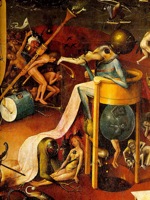Difference between revisions of "Hallucination"
m (moved Hallucinations to Hallucination) |
m (Text replacement - "http://" to "https://") |
||
| Line 3: | Line 3: | ||
==Origin== | ==Origin== | ||
[[Latin]] ''(h)allūcinārī'' (more correctly ''ālūcinārī''), to wander in [[mind]], talk idly, prate | [[Latin]] ''(h)allūcinārī'' (more correctly ''ālūcinārī''), to wander in [[mind]], talk idly, prate | ||
| − | *[ | + | *[https://en.wikipedia.org/wiki/17th_century 1629] |
==Definitions== | ==Definitions== | ||
*1a : [[perception]] of objects with no [[reality]] usually arising from disorder of the [[nervous system]] or in [[response]] to [[drugs]] (as LSD) | *1a : [[perception]] of objects with no [[reality]] usually arising from disorder of the [[nervous system]] or in [[response]] to [[drugs]] (as LSD) | ||
| Line 15: | Line 15: | ||
A mild form of hallucination is known as a disturbance, and can occur in any of the [[senses]] above. These may be [[things]] like, seeing movement in [[peripheral]] [[vision]], or hearing faint [[noises]] and/or [[voices]]. Auditory hallucinations are very common in paranoid schizophrenia. They may be benevolent (telling the patient [[good]] things about themselves) or malicious, [[cursing]] the patient etc. Auditory hallucinations of the malicious type are frequently heard like people talking about the patient behind their back. Like auditory hallucinations, the [[source]] of their visual [[counterpart]] can also be behind the patient's back. Their visual counterpart is the [[feeling]] of being looked-stared at, usually with malicious [[intent]]. Frequently, auditory hallucinations and their visual counterpart are [[experienced]] by the patient together. | A mild form of hallucination is known as a disturbance, and can occur in any of the [[senses]] above. These may be [[things]] like, seeing movement in [[peripheral]] [[vision]], or hearing faint [[noises]] and/or [[voices]]. Auditory hallucinations are very common in paranoid schizophrenia. They may be benevolent (telling the patient [[good]] things about themselves) or malicious, [[cursing]] the patient etc. Auditory hallucinations of the malicious type are frequently heard like people talking about the patient behind their back. Like auditory hallucinations, the [[source]] of their visual [[counterpart]] can also be behind the patient's back. Their visual counterpart is the [[feeling]] of being looked-stared at, usually with malicious [[intent]]. Frequently, auditory hallucinations and their visual counterpart are [[experienced]] by the patient together. | ||
| − | [ | + | [https://en.wikipedia.org/wiki/Hypnagogic_hallucination Hypnagogic hallucinations] and [https://en.wikipedia.org/wiki/Hypnopompia hypnopompic hallucinations] are considered [[normal]] [[phenomena]]. Hypnagogic hallucinations can occur as one is falling asleep and hypnopompic hallucinations occur when one is [[waking]] up. |
| − | Hallucinations can also be associated with [[drug]] use (particularly deliriants), [[sleep]] deprivation, psychosis, neurological disorders, and delirium tremens. [ | + | Hallucinations can also be associated with [[drug]] use (particularly deliriants), [[sleep]] deprivation, psychosis, neurological disorders, and delirium tremens. [https://en.wikipedia.org/wiki/Hallucination] |
[[Category: Health]] | [[Category: Health]] | ||
[[Category: Psychology]] | [[Category: Psychology]] | ||
Latest revision as of 00:01, 13 December 2020
Origin
Latin (h)allūcinārī (more correctly ālūcinārī), to wander in mind, talk idly, prate
Definitions
- 1a : perception of objects with no reality usually arising from disorder of the nervous system or in response to drugs (as LSD)
- b : the object so perceived
- 2: an unfounded or mistaken impression or notion : delusion
Description
A hallucination, in broadest sense of the word, is a perception in the absence of a stimulus. In a stricter sense, hallucinations are defined as perceptions in a conscious and awake state in the absence of external stimuli which have qualities of real perception, in that they are vivid, substantial, and located in external objective space. The latter definition distinguishes hallucinations from the related phenomena of dreaming, which does not involve wakefulness; illusion, which involves distorted or misinterpreted real perception; imagery, which does not mimic real perception and is under voluntary control; and pseudohallucination, which does not mimic real perception, but is not under voluntary control. Hallucinations also differ from "delusional perceptions", in which a correctly sensed and interpreted genuine perception is given some additional (and typically bizarre) significance.
Hallucinations can occur in any sensory modality — visual, auditory, olfactory, gustatory, tactile, proprioceptive, equilibrioceptive, nociceptive, thermoceptive and chronoceptive.
A mild form of hallucination is known as a disturbance, and can occur in any of the senses above. These may be things like, seeing movement in peripheral vision, or hearing faint noises and/or voices. Auditory hallucinations are very common in paranoid schizophrenia. They may be benevolent (telling the patient good things about themselves) or malicious, cursing the patient etc. Auditory hallucinations of the malicious type are frequently heard like people talking about the patient behind their back. Like auditory hallucinations, the source of their visual counterpart can also be behind the patient's back. Their visual counterpart is the feeling of being looked-stared at, usually with malicious intent. Frequently, auditory hallucinations and their visual counterpart are experienced by the patient together.
Hypnagogic hallucinations and hypnopompic hallucinations are considered normal phenomena. Hypnagogic hallucinations can occur as one is falling asleep and hypnopompic hallucinations occur when one is waking up.
Hallucinations can also be associated with drug use (particularly deliriants), sleep deprivation, psychosis, neurological disorders, and delirium tremens. [1]
